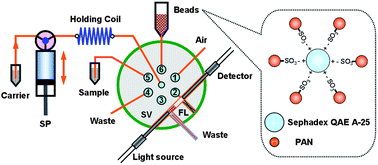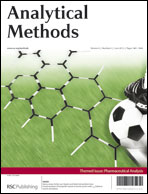An approach for the immobilization of a chromogenic reagent on solid phase micro-beads is performed via a sulfonation reaction. The product as an optical sensor is applied in lab-on-valve bead injection spectroscopy. The benzene ring structure exists in various chromogenic reagents, which facilitates the introduction of a sulfonic acid group via sulfonation. Chromogenic reagents ranging from neutral to anionic can be immobilized on anion exchanger micro-beads. As a model of application, micro-beads of Sephadex QAE A-25 loaded with the chromogenic reagent 1-(2-pyridylazo)-2-naphthol-sulfonic acid (PAN-S) are employed for the determination of trace cobalt by lab-on-valve bead injection spectroscopy. The characteristics of the micro-beads and some important parameters governing the performance of the method are investigated. With a sample volume of 1.0 mL, a detection limit of 8 μg L−1 and a linear range of 20–500 μg L−1 are obtained for cobalt, along with a RSD value of 2.8% (at the 200 μg L−1 level). The accuracy and practical applicability of the present method are validated by analysing a certified reference material of soil GBW07404, vitamin B12 injection and mecobalamin tablets, and further demonstrated by spiking recovery of cobalt in two water samples.

You have access to this article
 Please wait while we load your content...
Something went wrong. Try again?
Please wait while we load your content...
Something went wrong. Try again?


 Please wait while we load your content...
Please wait while we load your content...